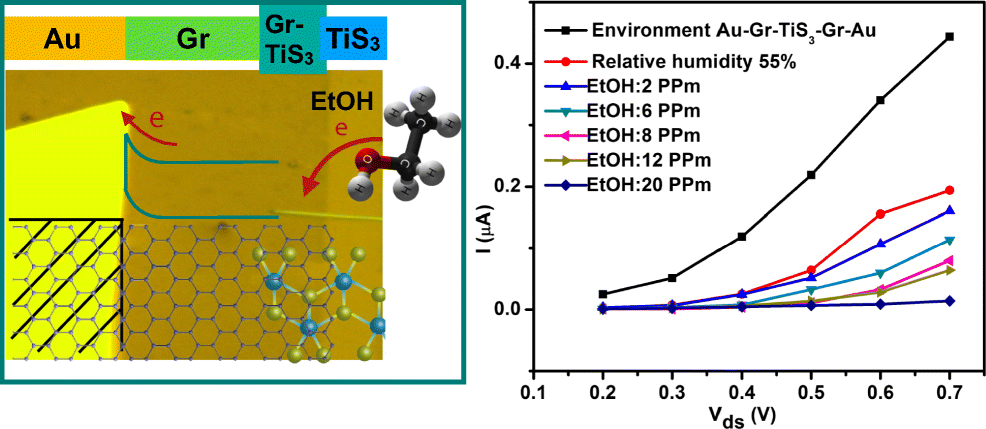当前位置:
X-MOL 学术
›
Microchim. Acta
›
论文详情
Our official English website, www.x-mol.net, welcomes your feedback! (Note: you will need to create a separate account there.)
A graphene/TiS3 heterojunction for resistive sensing of polar vapors at room temperature
Microchimica Acta ( IF 5.7 ) Pub Date : 2020-01-10 , DOI: 10.1007/s00604-019-4097-y Nassim Rafiefard 1 , Azam Iraji Zad 1, 2 , Ali Esfandiar 2 , Pezhman Sasanpour 3, 4 , Somayeh Fardindoost 2 , Yichao Zou 5 , Sarah J Haigh 5 , Seyed Hossein Hosseini Shokouh 6
Microchimica Acta ( IF 5.7 ) Pub Date : 2020-01-10 , DOI: 10.1007/s00604-019-4097-y Nassim Rafiefard 1 , Azam Iraji Zad 1, 2 , Ali Esfandiar 2 , Pezhman Sasanpour 3, 4 , Somayeh Fardindoost 2 , Yichao Zou 5 , Sarah J Haigh 5 , Seyed Hossein Hosseini Shokouh 6
Affiliation

|
The room temperature polar vapor sensing behavior of a graphene-TiS3 heterojunction material and TiS3 nanoribbons is described. The nanoribbons were synthesized via chemical vapor transport (CVT) and their structure was investigated by scanning electron microscopy, high resolution transmission electron microscopy, energy dispersive X-ray spectroscopy, X-ray diffraction, Raman and Fourier transform infrared spectroscopies. The gas sensing performance was assessed by following the changes in their resistivities. Sensing devices were fabricated with gold contacts and with lithographically patterned graphene (Gr) electrodes in a heterojunction Gr-TiS3-Gr. The gold contacted TiS3 device has a rather linear I-V behavior while the Gr-TiS3-Gr heterojunction forms a contact with a higher Schottky barrier (250 meV). The I-V responses of the sensors were recorded at room temperature at a relative humidity of 55% and for different ethanol vapor concentrations (varying from 2 to 20 ppm). The plots indicate an increase in the resistance of Gr-TiS3-Gr due to adsorption of water and ethanol with a relatively high sensing response (~495% at 2 ppm). The results reveal that stable responses to 2 ppm concentrations of ethanol are achieved at room temperature. The response and recovery times are around 8 s and 72 s, respectively. Weaker responses are obtained for methanol and acetone. Graphical abstract Schematic representation of resistance sensor for detection of low concentration of ethanol vapor. The graphene and TiS3 nanoribbons were synthesized using chemical vapor deposition and chemical vapor transport technique respectively. The 2D graphene/TiS3 heterojunction device was fabricated to make a high response sensor due to their synergy effect. Schematic representation of resistance sensor for detection of low concentration of ethanol vapor. The graphene and TiS3 nanoribbons were synthesized using chemical vapor deposition and chemical vapor transport technique respectively. The 2D graphene/TiS3 heterojunction device was fabricated to make a high response sensor due to their synergy effect.
中文翻译:

石墨烯/TiS3 异质结,用于在室温下对极性蒸汽进行电阻传感
描述了石墨烯-TiS3 异质结材料和 TiS3 纳米带的室温极性蒸汽传感行为。通过化学气相传输(CVT)合成纳米带,并通过扫描电子显微镜、高分辨率透射电子显微镜、能量色散 X 射线光谱、X 射线衍射、拉曼和傅里叶变换红外光谱研究其结构。通过跟踪其电阻率的变化来评估气体传感性能。传感装置制造有金触点和异质结 Gr-TiS3-Gr 中的光刻图案化石墨烯 (Gr) 电极。与金接触的 TiS3 器件具有相当线性的 IV 行为,而 Gr-TiS3-Gr 异质结与更高的肖特基势垒 (250 meV) 形成接触。传感器的 IV 响应是在室温、55% 的相对湿度和不同乙醇蒸汽浓度(从 2 到 20 ppm 不等)下记录的。该图表明 Gr-TiS3-Gr 的电阻增加,这是由于以相对较高的传感响应(2 ppm 时约 495%)吸附水和乙醇所致。结果表明,在室温下实现了对 2 ppm 乙醇浓度的稳定响应。响应时间和恢复时间分别约为 8 秒和 72 秒。甲醇和丙酮的响应较弱。图形摘要 用于检测低浓度乙醇蒸汽的电阻传感器的示意图。石墨烯和 TiS3 纳米带分别使用化学气相沉积和化学气相传输技术合成。由于其协同效应,2D 石墨烯/TiS3 异质结器件被制造成高响应传感器。用于检测低浓度乙醇蒸汽的电阻传感器示意图。石墨烯和 TiS3 纳米带分别使用化学气相沉积和化学气相传输技术合成。由于其协同效应,2D 石墨烯/TiS3 异质结器件被制造成高响应传感器。
更新日期:2020-01-10
中文翻译:

石墨烯/TiS3 异质结,用于在室温下对极性蒸汽进行电阻传感
描述了石墨烯-TiS3 异质结材料和 TiS3 纳米带的室温极性蒸汽传感行为。通过化学气相传输(CVT)合成纳米带,并通过扫描电子显微镜、高分辨率透射电子显微镜、能量色散 X 射线光谱、X 射线衍射、拉曼和傅里叶变换红外光谱研究其结构。通过跟踪其电阻率的变化来评估气体传感性能。传感装置制造有金触点和异质结 Gr-TiS3-Gr 中的光刻图案化石墨烯 (Gr) 电极。与金接触的 TiS3 器件具有相当线性的 IV 行为,而 Gr-TiS3-Gr 异质结与更高的肖特基势垒 (250 meV) 形成接触。传感器的 IV 响应是在室温、55% 的相对湿度和不同乙醇蒸汽浓度(从 2 到 20 ppm 不等)下记录的。该图表明 Gr-TiS3-Gr 的电阻增加,这是由于以相对较高的传感响应(2 ppm 时约 495%)吸附水和乙醇所致。结果表明,在室温下实现了对 2 ppm 乙醇浓度的稳定响应。响应时间和恢复时间分别约为 8 秒和 72 秒。甲醇和丙酮的响应较弱。图形摘要 用于检测低浓度乙醇蒸汽的电阻传感器的示意图。石墨烯和 TiS3 纳米带分别使用化学气相沉积和化学气相传输技术合成。由于其协同效应,2D 石墨烯/TiS3 异质结器件被制造成高响应传感器。用于检测低浓度乙醇蒸汽的电阻传感器示意图。石墨烯和 TiS3 纳米带分别使用化学气相沉积和化学气相传输技术合成。由于其协同效应,2D 石墨烯/TiS3 异质结器件被制造成高响应传感器。



























 京公网安备 11010802027423号
京公网安备 11010802027423号